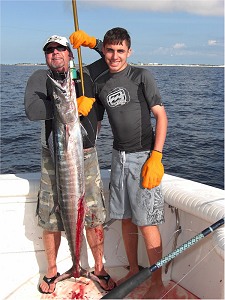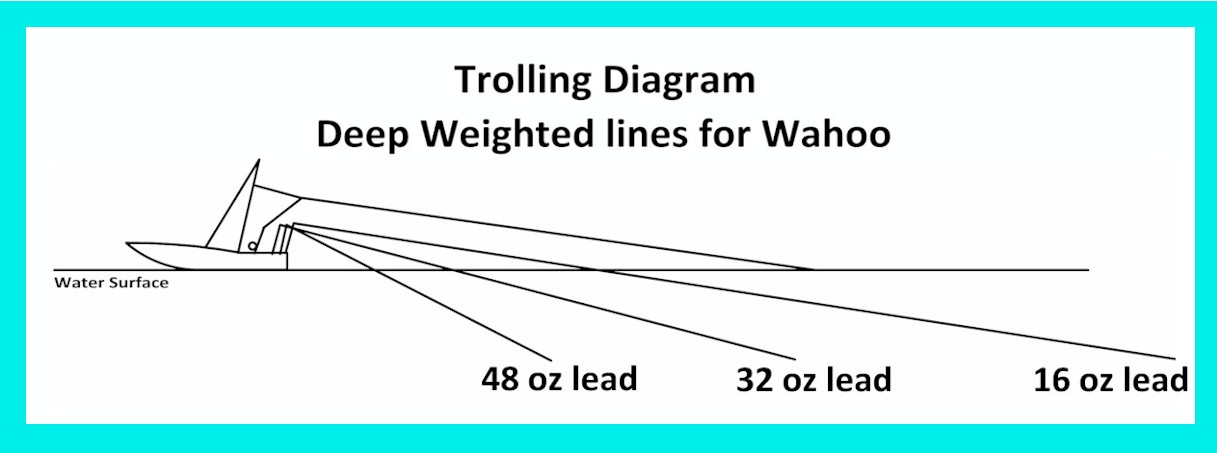|
Tips for Fishing for Wahoo
This Wahoo caught off of West End Grand Bahama Fishing for Wahoo is much like any other fishing, it is a bit of science, mixed with art, combined with a twist of instinct. There are many ways in which you can target this beautiful, fast, and tasty species. I will do my best to let you know them without making it sound too complicated. Of course, other fishermen will have their own ideas that may or may not be the same as my own, however, these methods will produce and you can use them with confidence. Getting local knowledge from a friend on how you may wish to add variations to some of these methods for best results in your area is always a good idea. Different Areas 1. In the Bahamas and other similar areas - 2. Near Palm Beach - 3. Offshore - Methods 1. Live Baiting on the edge and other currents with heavy bait concentrations - 2. Trolling the edge, and other currents with heavy bait concentrations, as well as Weedlines and Flotsam When trolling weeded areas, make sure not to pass your baits through weeds as reeling up a cigar sinker loaded with lead from 250 feet back is no fun.
3. Jigging for Wahoo - Find a current edge or flotsam as talked about above and plan to drift along that edge or flotsam while you deploy your favorite jigs. The amount of color and flash are always important and may possibly need to change from day to day for best results. Wahoo can be caught from the bottom all the way to the surface, but will usually be from the surface down to 60'. Drop your jigs to around 80' and work them up. Use Tormenter's CABLE RIGGED Jigging Hooks so you do not lose your fish. Wahoo Baits and Wahoo Lures Lures - Lures are almost always the choice amongst Wahoo Fishermen, especially those who troll high speed as natural bait will not withstand the punishment. The colors that become favorites among Wahoo Fishermen and the flash that is in some of them, also weight and size all become factors in the selection of the right lure for the right day. One of our smallest models, the STEEL HEAD is an excellent Wahoo lure, but then so is the Dart, The Super Smoker, The Wahoo Head, and other large models. Please go to our Wahoo Lures page to see what we recommend. Many people like to rig lures (and baits) with some sort of double hook rig as the Wahoo's jaw has soft membrane surrounding it which will easily tear and leave gaping holes for which the hook to fall out of. (see the section on actually catching the hooked Wahoo) Lure Colors - Black & Purple, Orange & Black, Black & Red, Blue & White, Zuchini, Pink, Chartreuse, did I say Black & Purple? Your friend may have some other "secrets" to share with you. Dead Bait - Trolled at 6 - 9 knots - Bonita Strip (behind our STEEL HEAD), Ballyhoo (naked or behind our Steel Head), Horse Ballyhoo (Split back with tandem hooks behind our Super Smoker, Dart, Smoker, Smoker Jr, or a Hawaiian Eye) Live Bait - Blue Runner, Goggle Eye, Greenie (also known as Thread Herring), Cigar Minnows, Ballyhoo, Pinfish, Mullet, Bonita, Speedos. Jigs - Of Course Tormenter's will provide the best action and color selection required to catch Wahoo. See them at our Wahoo Lure page. Fish On - Getting him to the boat! When getting a Wahoo bite, the natural instinct is to reach for the throttles and clutches to pull back to neutral as it seems this fish will spool you in no time, BUT, DO NOT, I repeat, DO NOT follow your instinct. Instead, do not throttle back, do not slow down, do not turn the boat. If you are in a turn, straighten the boat out so as to take out any belly in the line. After, and ONLY after, your angler is settled and ready to fight do you slow down, but do not pull the boat out of gear. This is the single most common mistake when fighting a Wahoo that will cause you to lose the fish. After his initial run, 9 out of 10 times, a Wahoo will then swim straight toward the boat shaking his head violently. You must keep the boat in gear (and possibly above idle speed) to help your angler keep the line tight to make it impossible for the Wahoo to shake the hook. As the Wahoo is torpedo shaped, and pointed straight at the boat, there will be very little resistance given after he has made his epic run. Stay in gear and make sure your angler keeps the rod bent and UP. Yes, he can pump and reel, but do not let him point the rod straight at the fish as you want the flex of the rod tip to take out the shock of the Wahoo's violent shaking. This will greatly increase your chances of keeping him on the hook. It is definitely not neccessary to bring in the other lines unless you hooked your Wahoo on a line way back as his moves are predictable and if you keep the boat in gear and if your fish stays below your other lines, you should have no trouble, but if in doubt, reel them in. Gaffing a Wahoo This has its own section as it is very important to know. First, do NOT pull the boat out of gear. Keep going straight ahead, usually at around 5 knots is best. When the fish starts to get close, have your angler move forward so that when the angler gets the leader to the rod tip and the fish comes to the boat, he will be along side the boat and not behind it. Teach your anglers this move when catching Tuna, Wahoo, Dolphin, and other pelagics. It will make you look like a true expert when it comes to landing a fish. With a Wahoo laying along side the boat, he is a perfect target for even the most inexperienced Gaff Man. While keeping the boat moving ahead, as the angler gets the fish to where his head is forward of the transom and in front of the Gaff Man, the Gaff Man can then easily reach over the fish with the gaff and steadily pull the gaff (with the hook pointed downward) until the fish is over the gunnel and in the boat. If you are using a transom fish box, I STRONGLY recommend that you land the fish on the deck, get full control of him, and then place him in the box. Don't forget to ice him down as soon as you get the cockpit settled and any lines back out. If you have caught your Wahoo on a trolling rig with a long leader and a wire man is needed, the wire man needs to pull gently and quickly enough to keep the fish from swimming faster than the retrieval of the leader. It must be a smooth motion and you MUST be ready to land the gaff as soon as the Wahoo is next to the boat. If you are not ready, and do not sink the gaff as soon as the fish is next to the boat, your chances of getting him in the boat will decrease rapidly. If a Wahoo is caught trolling with a 8/0 hook or larger, I can almost guarantee that 50% of your fish will have the hooks fall out after landing on the deck. This is why it is so important to keep the boat moving ahead and use the rod tip to absorb shock. Gaffing any fish (other than a bottom species) behind the boat is not a good move. Only do this when a fish will not come along side. Good Luck! Click on this link to be directed to our |









































